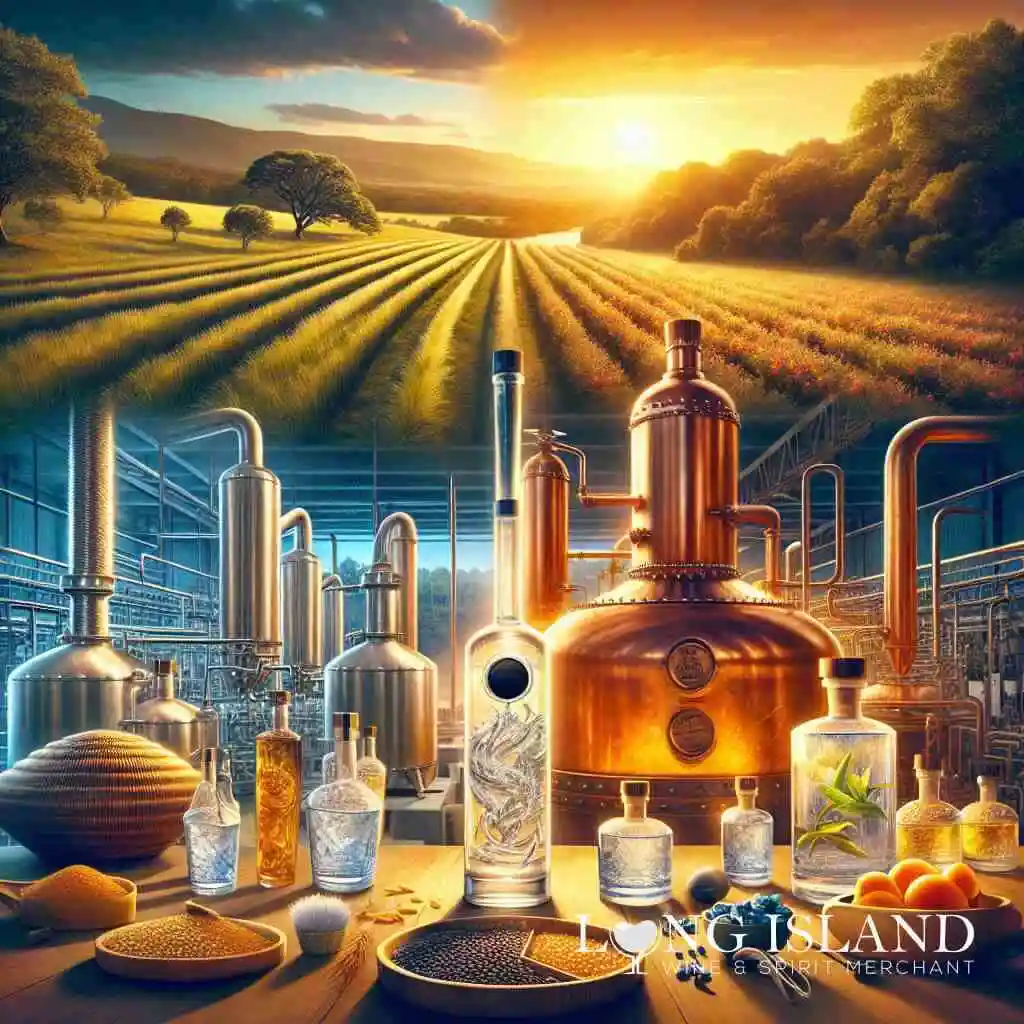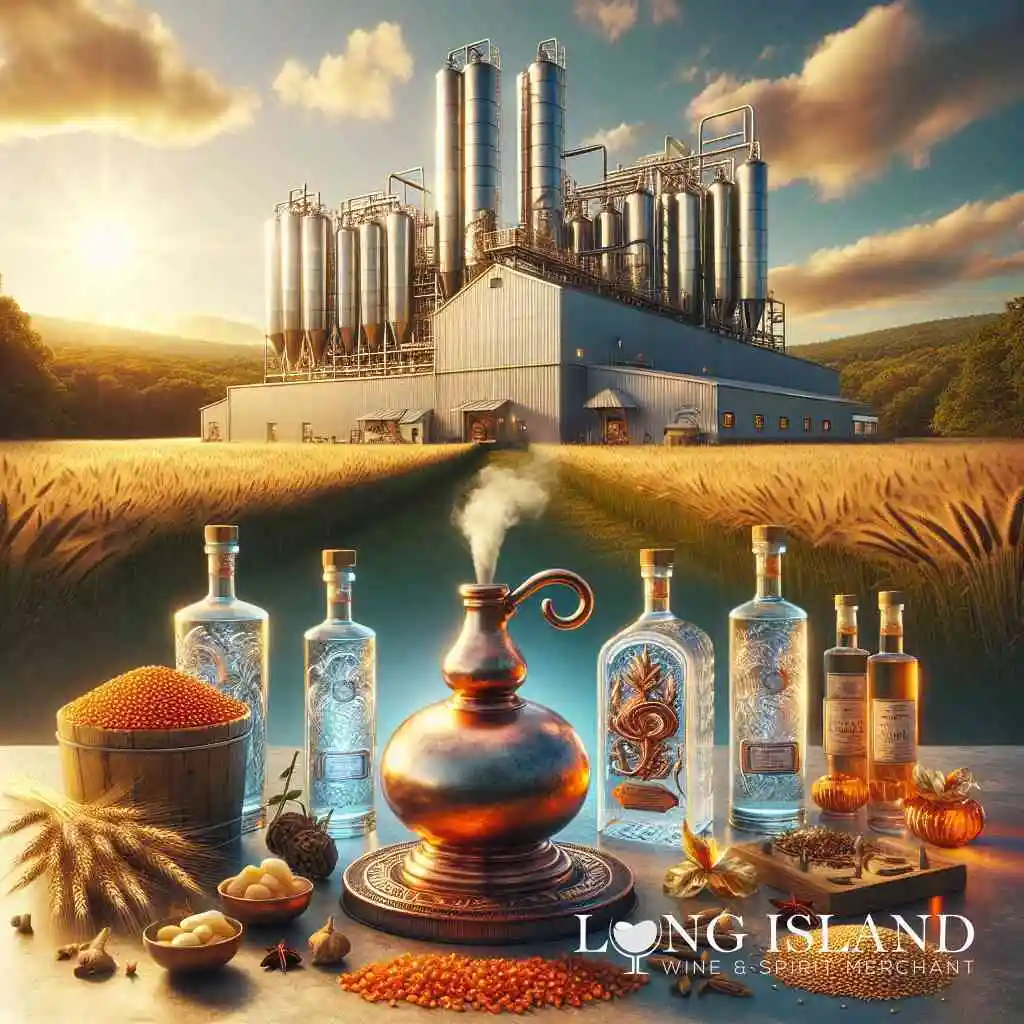
The Difference Between Craft and Commercial Vodka in Long Island
October 10, 2025
Unveiling the Vodka Spectrum
Crafting Liquid Art: The Soul of Craft Vodka
Craft vodka in Long Island stands as a testament to artistry and precision. These small-batch vodkas are crafted with a fervent commitment to quality and authenticity, showcasing the mastery of local distillers. By selecting unique ingredients and employing meticulous techniques, craft vodka makers create unparalleled flavor profiles. Each bottle encapsulates the essence of creativity, making it a liquid masterpiece. Passionate distillers on Long Island are indeed redefining the vodka narrative through innovation and dedication.
Craft vodka distilleries focus on the nuances that differentiate their spirits from commercial mass-produced versions. This often involves using distinct techniques to control various aspects of the production process, from fermentation to bottling. By doing so, the flavor profiles are carefully designed to reflect both the local terroir and the distiller’s vision. It’s a dance between science and art, resulting in a spirit that’s savored by those seeking an elevated vodka-sipping experience. Discover these artisanal creations at select craft vodka in Long Island.
At Scale: The World of Commercial Vodka Production
Commercial vodka production operates on a vastly different scale, prioritizing quantity and consistency. Large-scale distilleries use standardized methods to produce vodka quickly and efficiently, catering to a global market. The focus here is on maintaining a uniform taste across millions of bottles, providing a reliable product for consumers worldwide.
Such production methods often involve continuous distillation processes that streamline operations but might sacrifice nuanced flavors for the sake of efficiency. Despite this, commercial vodkas remain popular due to their accessibility and consistent quality. Consumers can expect the same taste experience regardless of location, which is a significant draw for many. Thus, while commercial vodka may lack the personalized touch of craft, its reliable quality continues to capture a considerable part of the market.
Local Gems: Long Island Craft Vodka Distilleries
Long Island boasts a burgeoning scene of craft vodka distilleries that are rapidly gaining acclaim. These distilleries not only provide a unique tasting experience but also contribute to the local economy by emphasizing homegrown ingredients and creativity. The often family-owned distilleries are steered by passionate craftsmen dedicated to their craft, bringing distinctive flavors to the fore.
The burgeoning industry of Long Island craft vodka distilleries reflects a community’s commitment to excellence and innovation. Each establishment adds its own personal touch to the spirits it produces, often incorporating local ingredients that highlight the region’s unique terroir. Embark on a journey through Long Island craft vodka distilleries to explore these exceptional offerings. By supporting local producers, consumers actively contribute to preserving the artisanal craftsmanship that distinguishes these vodkas.
The Core Ingredients to Liquid Gold
Beyond the Ordinary: Unique Ingredients in Craft Vodka
Craft vodka distillers on Long Island are shaking up the traditional vodka scene by incorporating extraordinary ingredients. These distillers often source local and organic components, including artisanal grains and rare botanicals. By using natural ingredients, craft vodka enthusiasts can enjoy refined spirits with a distinct personality and depth.
The emphasis on quality and uniqueness means every bottle bears a mark of individuality. Even the water used in the distillation process is selected with precision, contributing to the subtle flavors and aromas that set craft vodkas apart. Such dedication to sourcing eco-conscious ingredients underscores why many regard craft vodka as a celebration of vodka customization options.
Mass Appeal: The Standard Ingredients of Commercial Vodka
In contrast, commercial vodkas primarily rely on mass-produced ingredients to maintain product consistency and meet high consumer demand. Commonly used components include commercially cultivated grains and purified water, which are standardized to streamline production across vast scales. These ingredients afford commercial vodkas a predictable taste that appeals to a broad market.
The processing of these ingredients often involves extensive filtering to achieve a neutral flavor, making commercial vodka a versatile base for various cocktails. Such consistency is a cornerstone of the industry’s success, enabling widespread availability and a recognizable taste profile that millions of consumers expect from every bottle of Long Island commercial vodka.
Terroir Terrors: Long Island’s Own Vodka Ingredients
Long Island’s craft vodka scene is flourishing, leveraging its unique terroir to create spirits that capture the essence of the region. The area’s fertile soil supports the growth of exceptional raw materials, such as potatoes and grains, that serve as foundational ingredients for local distilleries. These natural components not only contribute to flavor but also represent the island’s rich agricultural legacy.
By emphasizing locally sourced ingredients, Long Island distilleries are carving a niche within the complex tapestry of alcohol production. This approach reinforces the bond between the final vodka product and the land from which it originates. As a result, enthusiasts embarking on a vodka tasting in Suffolk County are treated to an authentic experience that mirrors the region’s environment and character.
Decoding Distillation: Processes and Purity
Small Batch Perfection: The Craft Vodka Distillation Process
Craft vodka embodies a meticulous approach to distillation that highlights both quality and character. Small-batch production allows distillers to closely monitor every step, from grain selection to distillation itself. Distillers often employ pot stills, which allow for greater control over the distillation process. This careful monitoring preserves the intricate flavors unique to each batch. The use of pot stills, as opposed to column stills, ensures that craft vodka remains a vibrant expression of the distiller’s skilled artistry. Delving into the vodka distillation process unveils the depth of effort behind each bottle of craft vodka, emphasizing purity and complexity.
The resulting spirit offers a tasting experience rich in nuance, capturing the very essence of its ingredients. Each sip tells a story of the distillation journey, where human touch harmonizes with natural processes. Long Island’s craft distilleries are shining examples of this devotion, showcasing how small-scale production can yield magnificent results.
Quantity Over Quality: Commercial Vodka’s Mass Production
In contrast, commercial vodka producers prioritize volume and uniformity above all. Their distillation processes often utilize continuous column stills, designed for efficiency and speed. These industrial methods focus on producing large quantities rapidly, ensuring their brands dominate both in liquor stores and bars globally. While these techniques facilitate widespread distribution, the emphasis on efficiency sometimes diminishes the vodka’s depth.
Continuous distillation strips away many of the flavors and complexities that define craft vodka, resulting in a spirit that’s neutral in taste. Nevertheless, this approach appeals to a vast audience, providing a blank canvas for cocktails. Commercial vodka stands as a testament to modern manufacturing innovations, where consistency is key to meeting global demand.
The Purity Gauge: How Distillation Affects Flavor
Distillation purity is crucial for vodka, as it influences the final flavor and smoothness of the spirit. Craft distilleries on Long Island achieve high purity by carefully refining their techniques, often embracing multiple distillation cycles. This repeated refining purges impurities, leaving behind a silky, clean spirit. The choice of stills and temperature control plays a monumental role in refining flavor.
For commercial vodkas, purity is primarily achieved through filtration post-distillation, using methods such as charcoal filtration. This approach ensures an ultra-neutral taste, catering to diverse palates, but may lack the distinctive character often craved by connoisseurs. Whether enjoyed neat or mixed, the purity of vodka directly impacts the overall experience, making it fundamental to both production strategies. Understanding the vodka production methods unlocks greater appreciation for the artistry and science inherent in the drink, highlighting the spectrum from craft excellence to commercial proficiency.
Sophistication in Every Sip: Tasting Profiles
Deconstructing the Craft Vodka Tasting Experience
Craft vodka offers a rich and diverse tasting journey that stands in stark contrast to its commercial counterparts. Crafted with precision and passion, each bottle presents a unique vodka flavor profile. These small-batch vodkas are prized for their ability to surprise the palate with nuanced notes that speak to both the ingredients and the maker’s artistry. Enthusiasts often describe the experience as being akin to embarking on a journey through the senses, where each sip reveals another layer of complexity. Whether it’s the subtle sweetness of locally grown grains or the aromatic hints of rare botanicals, craft vodka stands as a testament to the depth of character that individual craftsmanship can instill.
Craft vodkas from Long Island capture the region’s vibrant spirit, emphasizing the connection between local terroir and taste. With every sip, connoisseurs are treated to a liquid embodiment of Long Island’s cultural and culinary heritage, demonstrating the potent influence of local ingredients. The craft vodka tasting experience is indeed an exploration of sophistication and identity, inviting vodka aficionados to delve deeper into the world of Long Island spirits insights.
The Consistent World of Commercial Vodka Tastes
Commercial vodkas promise consistency above all, offering consumers a reliable taste profile across every bottle and brand. This standardized experience means that whether you’re sipping in Soho or celebrating in Seattle, the vodka’s taste remains steadfast. By prioritizing uniformity and efficiency, commercial vodkas deliver a versatile spirit that serves as an ideal base for cocktails, such as martinis and cosmopolitans. Although this consistency comes at the expense of the intricate flavors characterized by craft spirits, it provides a familiar and reliable drinking experience enjoyed by millions.
Global brands have excelled in perfecting the neutral palate of commercial vodka, ensuring it pairs seamlessly with a diverse array of mixers. This predictable taste is particularly appealing in social settings, where a dependable drink can streamline the beverage selection process. As a result, commercial vodka plays an influential role in the broader vodka taste profiles near Long Island, offering a stable complement to more adventurous craft offerings.
Suffolk County’s Vodka Tasting Adventures: Where Craft Meets Consumer
Suffolk County serves as a vibrant hub for vodka aficionados eager to explore diverse sipping experiences. Combining traditional craft with consumer convenience, the local vodka scene offers tasting experiences that showcase the best of both worlds. Visitors can embark on local vodka adventures, engaging with producers who are eager to share their passion and expertise. These tastings often highlight the distinct differences between craft and commercial vodkas, inviting participants to savor and compare their flavors, ingredients, and stories.
Long Island vodka distilleries in Suffolk County provide a captivating backdrop for these tastings. Set amidst lush landscapes and scenic vistas, these establishments offer a profound appreciation for the convergence of creativity and commerce in the production of vodka. As the local vodka scene continues to thrive, consumers are encouraged to explore the evolving landscape of vodka sipping experiences near Suffolk that harmonize tradition and modernity.
Conclusion: A Toast To Vodka Diversity
Choosing Your Vodka: Navigating Long Island’s Vodka Scene
Selecting the perfect vodka can be an exhilarating journey through the diverse landscape of Long Island’s vibrant spirits industry. From the exquisite craftsmanship of small-batch artisan distilleries to the mass appeal of commercial giants, there’s a vodka for every palate and occasion. When perusing Long Island vodka brands, consider your flavor preferences, desired level of refinement, and event characteristics. For an elevated sipping experience, craft vodkas from local producers offer unparalleled richness in taste and character. Meanwhile, if versatility in cocktails is your priority, commercial vodkas offer consistent quality, providing a reliable base for any libation.
Long Island enthusiasts can navigate this intricate vodka scene by visiting local distilleries or exploring comprehensive selections at notable stores, such as Long Island Liquor Store. By understanding the balanced dynamics between craft and commercial offerings, you gain access to a spectrum of vodka experiences, ready to be discovered and celebrated.
The Future: Crafting and Commercial Trends in Local Vodka
As we gaze into the future of Long Island’s vodka industry, a fusion of tradition and innovation defines the progression of both craft and commercial production. Craft vodka continues to pave the way with sustainable practices, emphasizing local sourcing and ecological consciousness. Distilleries are experimenting with novel ingredients and advanced distillation technologies to reduce the environmental footprint of their products. Such refinement not only caters to the discerning tastes of enthusiasts but also aligns with broader trends towards sustainability and authenticity.
Conversely, commercial vodka endeavors to maintain its widespread appeal by integrating high-tech production methods and strategic branding. This focus on efficiency and global reach ensures that established brands maintain a significant market share. As interest in sustainability and customization grows, the industry is poised to adapt, offering innovative products that strike a balance between mass appeal and enhanced quality. Both segments contribute richly to the ongoing evolution of the Long Island liquor and spirits landscape, ensuring the region remains a vibrant hub for vodka aficionados seeking both the distinctiveness of artisanal craftsmanship and the dependability of commercial excellence. With a future that harmonizes diverse production styles, Long Island remains a captivating destination for vodka enthusiasts worldwide.
Frequently Asked Questions
Question: How does Long Island Liquor Store differentiate between craft vodka and commercial vodka when selecting products to offer?
Answer: At Long Island Liquor Store, we are committed to providing our customers with a diverse range of vodka options that cater to different preferences and occasions. When selecting craft vodka, we focus on small-batch vodkas that emphasize unique flavor profiles, premium ingredients, and artisanal distillation processes. These craft vodkas often highlight local ingredients and the creativity of Long Island vodka distilleries. On the other hand, our selection of commercial vodkas includes brands that ensure consistency, quality, and versatility for cocktail-making. We aim to offer both craft and commercial vodka enthusiasts a wide range of choices from Long Island’s vibrant spirits scene.
Question: What are the core ingredient differences between the craft vodka and commercial vodka available at Long Island Liquor Store?Answer: The core ingredient differences between craft vodka and commercial vodka revolve around their sourcing techniques and production scales. Craft vodkas often utilize local and organic ingredients such as artisan grains and rare botanicals, which contribute to distinct and rich flavor profiles. The selection of these unique components, including natural and locally sourced water, infuses craft vodka with its characteristic depth and personality. In contrast, commercial vodkas typically employ mass-produced ingredients, including commercially cultivated grains and purified water, to ensure consistent taste from bottle to bottle. Both options are available at Long Island Liquor Store, providing customers with access to an impressive variety of Long Island vodka brands that highlight these differences.
Question: In the blog ‘The Difference Between Craft and Commercial Vodka in Long Island,’ how does Long Island Liquor Store contribute to the Suffolk County vodka tasting scene?
Answer: Long Island Liquor Store is an integral part of the Suffolk County vodka tasting scene by offering a curated selection of both craft and commercial vodkas. We provide enthusiasts with opportunities to explore the intricate relationships between flavors, ingredients, and production methods through our diverse assortment. Customers can engage with both local vodka producers and world-renowned brands, each offering a unique tasting experience. Our store’s commitment to showcasing Long Island spirits helps support the regional economy, encourages local innovation, and provides a platform for Suffolk County vodka distilleries to make their mark in the community
Question: How does Long Island Liquor Store ensure vodka lovers find the right product for their palate, whether it’s premium craft vodka or versatile commercial vodka?
Answer: At Long Island Liquor Store, our approach to helping vodka lovers find the right product involves offering personalized recommendations and insights into our extensive selection. We feature a wide variety of Long Island vodka brands that cater to different taste preferences, from the robust and nuanced profiles of premium craft vodka to the steadfastly neutral and versatile profiles of commercial vodka. Our knowledgeable staff guides customers through our offerings, ensuring they discover vodkas that align with their flavor preferences and intended uses. By prioritizing customer satisfaction and offering a comprehensive selection, we strive to enhance the vodka-sipping experience for all.




